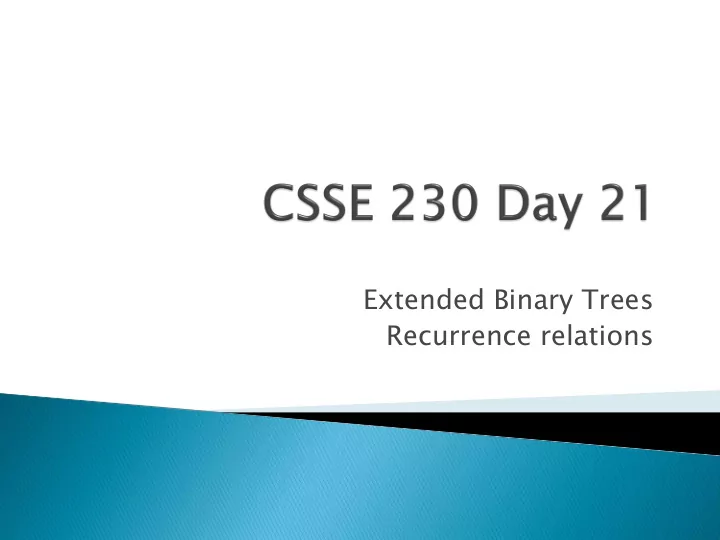

Extended Binary Trees Recurrence relations
Today: ◦ Extended Binary Trees (basis for much of WA8) ◦ Recurrence relations, part 1 ◦ EditorTrees worktime
Bringing new life to Null nodes!
1-2 An Extended Binary tree is either ◦ an external nal (nu null ll) no node , or ◦ an ( intern rnal al ) root node and two EBTs T L and T R . We draw internal nodes as circles and external nodes as squares. ◦ Generic picture and detailed picture. This is simply an alternative way of viewing binary trees, in which we view the external nodes as “places” where a search can end or an element can be inserted.
3-10 10 Prope perty rty P(N): For any N>=0, any EBT with N internal nodes has _______ external nodes. Proo roof by by stro trong in indu duction, based on the recursive definition. ◦ A notation for this problem: IN(T), EN(T) ◦ Note that, like a lot of other simple examples, this one can be done without induction. ◦ But one purpose of this exercise is practice with strong induction, especially on binary trees. What is the crux of any induction proof? ◦ Finding a way to relate the properties for larger values (in this case larger trees) to the property for smaller values (smaller trees). Do o th the e proof oof n now ow.
A technique for analyzing recursive algorithms
11 11 Split the sequence in half Where can the maximum subsequence appear? Three possibilities : ◦ entirely in the first half, ◦ entirely in the second half, or ◦ begins ns in the first half and end nds in the second half
Using recursion, find the maximum sum of 1. firs irst half of sequence Using recursion, find the maximum sum of 2. seco econd half of sequence Compute the max of all sums that begin in 3. the first half and end in the second half ◦ (Use a couple of loops for this) Choose the largest of these three numbers 4.
12 12-13 13 So, what’s the run-time?
14 14 Use a Rec ecurrence R Rel elation ◦ A function of N, typically written T(N) ◦ Gives the run-time as a function of N ◦ Two (or more) part definition: Base case, like T(1) = c Recursive case, like T(N) = T(N/2) So, what’s the recurrence relation for the recursive MCSS algorithm?
15 15-16 16 What’s N in the base case?
An equation (or inequality) that relates the n th element of a sequence to certain of its predecessors (recursive case) Includes an initial condition (base case) Solu olutio ion: A function of n. Similar to differential equation, but discrete instead of continuous Some solution techniques are similar to diff. eq. solution techniques
18 18-20: Skip Skip 1 17 for n or now ow One strategy: gu gues ess a and ch chec eck Examples: ◦ T(0) = 0, T(N) = 2 + T(N-1) ◦ T(0) = 1, T(N) = 2 T(N-1) ◦ T(0) = T(1) = 1, T(N) = T(N-2) + T(N-1) ◦ T(0) = 1, T(N) = N T(N-1) ◦ T(0) = 0, T(N) = T(N -1) + N ◦ T(1) = 1, T(N) = 2 T(N/2) + N (just consider the cases where N=2 k )
20 20 Substi titu tuti tion on T(1) = 1, T(N) = 2 T(N/2) + N (just consider N=2 k ) Suppose we substitute N/2 for N in the recursive equation? ◦ We can plug the result into the original equation!
Guess and check Substitution Telescoping and iteration The “master” method
What’s N?
Consider: ◦ T(1) = 1 ◦ T(N) = N + T(N/2), where N = 2 k for some k Substitution: ◦ Use recurrence relation repeatedly to expand T() on right-hand side of relation
Recommend
More recommend